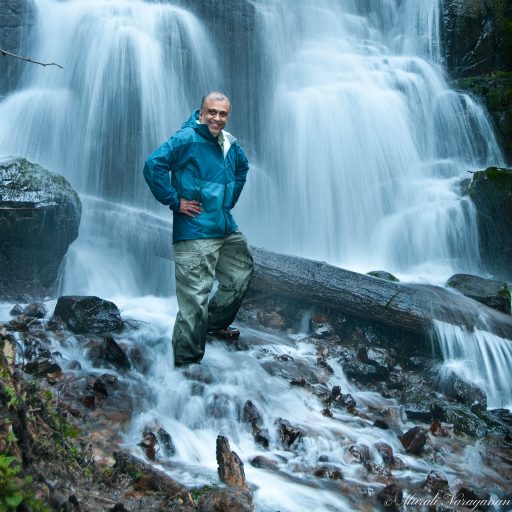Day 1
We checked out of our hotel early in the morning and walked to the Termini to catch the 0700 Trenitalia high speed Frecce train to Florence. Florence was the first stop about 275 km away and the train reached our destination at around 0845. We walked across the street to the B&B and checked in. We dumped our luggage in the room and walked to the Piazza di San Lorenzo to grab an early lunch.

43°46’30.4″N 11°15’10.7″E
It was a beautiful day with puffy clouds. We ordered Italian sandwich for early lunch. The restaurant was relatively busy. After the lunch, we returned to the B&B to pick up our tickets for the museum visits and the camera equipment. Our first museum visit was to the Galleria dell’Accademia. Main attraction at the Gallaria is Michelangelo’s David. We avoided standing line by booking the tickets including date and time 3 weeks before we left for Italy.
Galleria dell’Accademia
The Galleria dell’Accademia was founded in 1784 by Pietro Leopoldo, Grand Duke of Tuscany. There was a massive crowd to get in. When they announced our time slot (1200), we stood in line. After going through security pretty close to TSA, we entered the Galleria at about 1220. We turned on Rick Steves’s Accademia audio tour to see just the highlights.
Michelangelo’s David was originally commissioned as one of a series of statues of prophets to be positioned along the roofline of the east end of Florence Cathedral (Duomo). On 25 January 1504, when the sculpture was nearing completion, Florentine authorities had to acknowledge there would be little possibility of raising the more than six-ton statue to the roof of the cathedral. It was instead placed in a public square, outside the Palazzo Vecchio, the seat of civic government in Florence, in the Piazza della Signoria, where it was unveiled on 8 September 1504. The statue was moved to the Galleria in 1873, and later replaced at the original location by a replica.The original intention was to create a “Michelangelo museum”, with original sculptures and drawings, to celebrate the fourth centenary of the artist’s birth. Today, the gallery has a small collection of Michelangelo’s sculptures. Rest are at various museums in Italy and possibly in other countries.
Michelangelo was just 25 when he created David in marble. The statue is 17.0 ft tall. Because of the nature of the hero it represented, the statue soon came to symbolize the defense of civil liberties embodied in the Republic of Florence, an independent city-state threatened on all sides by more powerful rival states and by the hegemony of the Medici family. The eyes of David, with a warning glare, were fixated towards Rome. The proportions of the David are atypical of Michelangelo’s work; the figure has an unusually large head and hands (particularly apparent in the right hand). These enlargements may be due to the fact that the statue was originally intended to be placed on the cathedral roofline, where the important parts of the sculpture may have been accentuated in order to be visible from below.

43°46’36.8″N 11°15’31.5″E
Next to the David is the Palestrina Pietà, a marble sculpture dating from c. 1555. It was formerly attributed to Michelangelo, but now it is mostly considered to have been completed by someone else, such as Niccolò Menghini or Gian Lorenzo Bernini. This Pietà depicts three figures, one of them the body of Jesus Christ.

The Rape of the Sabine Women, also known as The Abduction of the Sabine Women or The Kidnapping of the Sabine Women, was an incident in Roman mythology in which the men of Rome committed a mass abduction of young women from the other cities in the region. 16th-century Italo-Flemish sculptor Giambologna sculpted a representation of this theme with three figures (a man lifting a woman into the air while a second man crouches), carved from a single block of marble. This sculpture is considered Giambologna’s masterpiece and is on display at the Academia. A copy is on display at the Piazza della Signoria.

Piazza della Signoria
It was around 2pm when we left the Academia. Our next museum entry was at the Medici family’s Uffizi Gallery at 4pm. We had about 2 hours to walk around Piazza della Signoria where the Uffizi is located. The Piazza is full of statues, restaurants, and gelato shops. We grabbed a gelato each and sat among the statues at the Loggia dei Lanzi. Below are some images shot at the piazza.
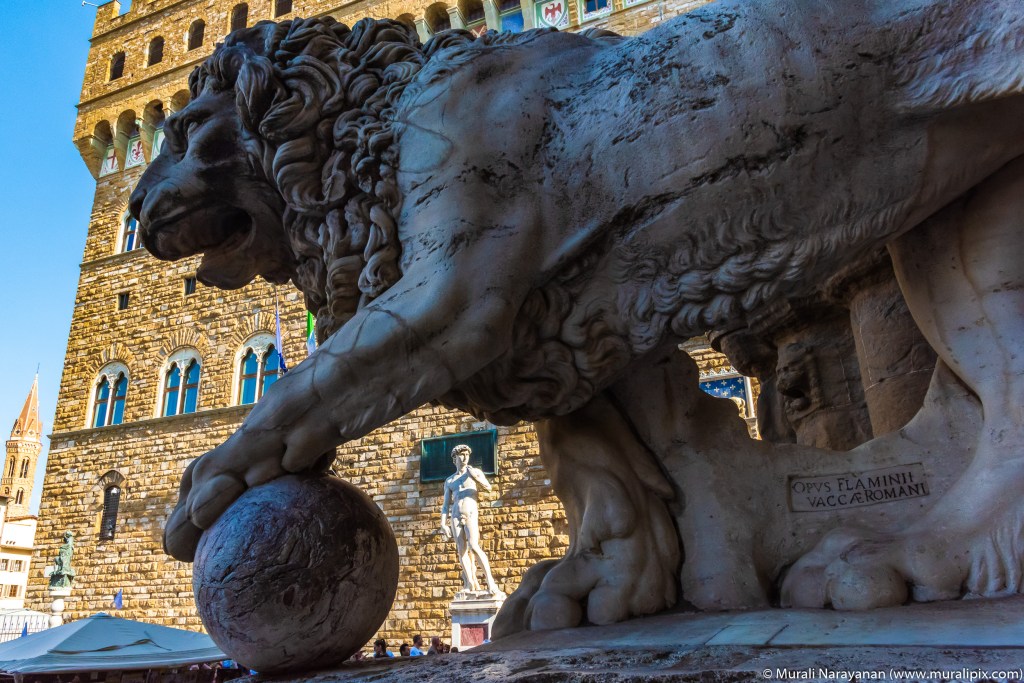
43°46’09.2″N 11°15’20.4″E

43°46’09.2″N 11°15’20.4″E
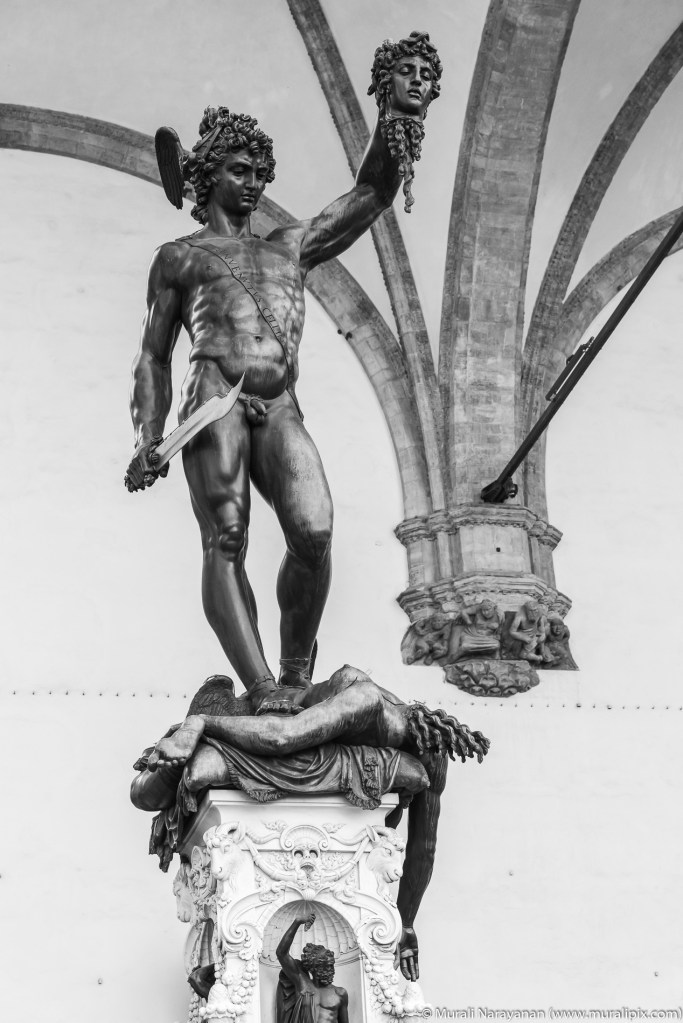

43°46’11.2″N 11°15’21.5″E
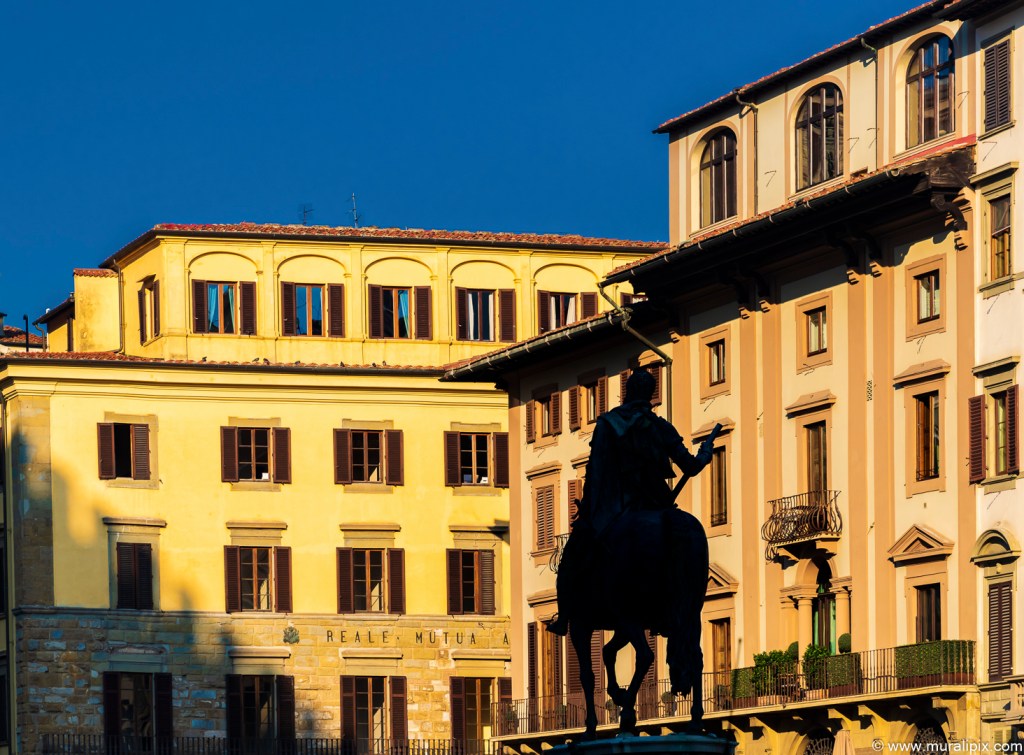
43°46’11.2″N 11°15’22.2″E

43°46’10.3″N 11°15’21.6″E
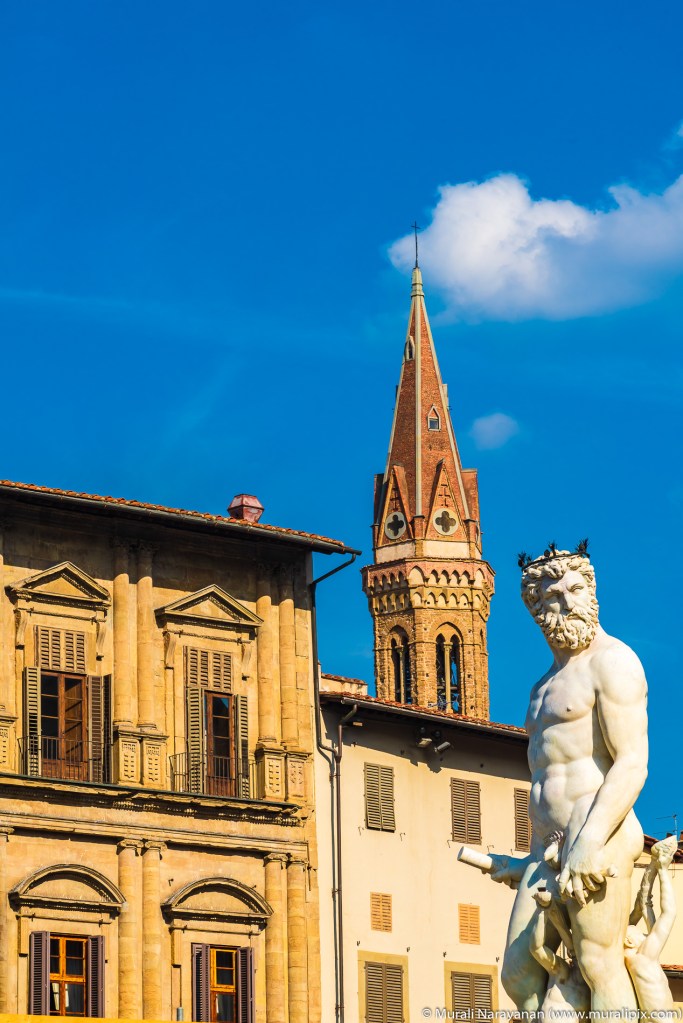
43°46’10.3″N 11°15’21.2″E
It turned out to be a challenge to get to a restroom around Piazza della Signoria. I walked into a few hotels and restaurants with no success. Finally found the Hotel Bernini Palace where the Concierge allowed me to use their restaurant. When I was walking out, I found a beautiful view of the Campanile Della Basilica Di Santa Croce. The image I captured from the lobby of the hotel below.

43°46’09.7″N 11°15’27.6″E

43°46’05.7″N 11°15’19.8″E
The Uffizi Gallery
The Uffizi Gallery is a prominent art museum located adjacent to the Piazza della Signoria. One of the most important Italian museums and the most visited, it is also one of the largest and best known in the world and holds a collection of priceless works, particularly from the period of the Italian Renaissance.
The building of Uffizi complex was begun in 1560 for Cosimo I de’ Medici so as to accommodate the offices of the Florentine magistrates, hence the name uffizi, “offices”. It was completed in 1581. The top floor was made into a gallery for the family and their guests and included their collection of Roman sculptures. Over the years, more sections of the palace were recruited to exhibit paintings and sculpture collected or commissioned by the Medici. For many years, 45 to 50 rooms were used to display paintings from the 13th to 18th century.
Because of its huge collection, some of the Uffizi’s works have in the past been transferred to other museums in Florence—for example, some famous statues to the Bargello. A project was finished in 2006 to expand the museum’s exhibition space about 64,000 ft2 to almost 139,000 ft2, allowing public viewing of many artworks that had usually been in storage.
At 345pm, we picked up the tickets to the Uffizi gallery and entered the museum at 4. As there was so much to see in 2 hours, I decided not to do any photography. We had viewed a bunch of documentaries on YouTube and videos on Khan Academy on Renaissance and so we knew what to see. Prioritization is a must when you only have 2 hours to see the gallery. We focused on the works of Sandro Botticelli, Michelangelo, Leonardo da Vinci, Raphael, and Fra Filippo Lippi.
After a terrific dinner, we got back to our room at around 10pm.
Day 2
Ponte Vecchio
After a quick/early breakfast at a bakery next to the B&B, we walked to the Ponte Vecchio, a medieval stone closed-spandrel segmental arch bridge over the Arno River.
The bridge first appears in a document of 996 and was destroyed by a flood in 1117 and reconstructed in stone. It was the only bridge across the Arno in Florence until 1218. The current bridge was rebuilt after a flood in 1345. During World War II it was the only bridge across the Arno that the fleeing Germans did not destroy. Instead they blocked access by demolishing the medieval buildings on each side.
It is noted for the shops built along it. Butchers, tanners, and farmers occupied the shops since the 13th century. In 1593, Ferdinand I decreed that only goldsmiths and jewelers be allowed to have their shops on the bridge in order to improve the well-being of all, including their own as they walked over the bridge.The present tenants are jewelers, art dealers, and souvenir sellers.
We spent about 2 hours crossing the bridge, walking along both sides of the river, and doing some window shopping on the bridge.

43°46’05.7″N 11°15’14.3″E

43°46’06.5″N 11°15’12.1″E

43°46’01.2″N 11°15’16.3″E
When the Medici moved from Palazzo Vecchio to Palazzo Pitti, they decided they needed a connecting route from the Uffizi to the Palazzo Pitti on the other side of the Arno that would enable them to keep out of contact with the people they ruled. The result was the Corridoio Vasariano (Vasari”s Corridor), built in 1565 by Giorgio Vasari and which runs above the little goldsmiths’ shops on the Ponte Vecchio. It has been closed since 2016 for security reasons but is scheduled to reopen in 2021 to the general public. I won’t be surprised if you have to book a year in advance to get a ticket.
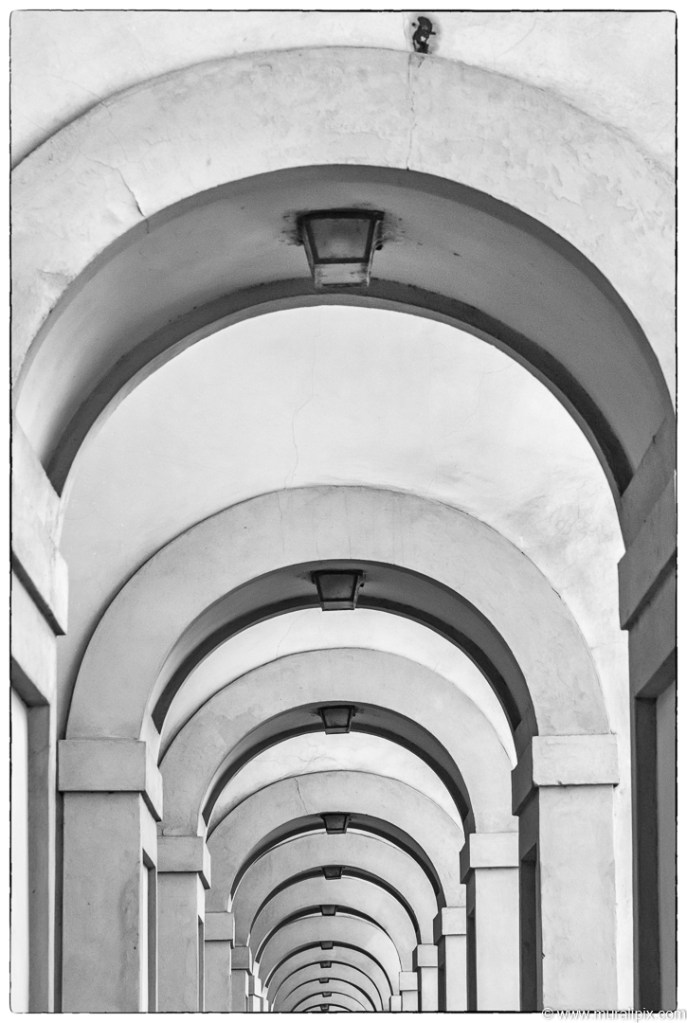
43°46’05.7″N 11°15’14.3″E

Piazza della Repubblica
From the Ponte Vecchio, we walked to the Piazza della Repubblica, originally the site of the city’s forum during the Roman era.
During medieval times the area was densely populated with markets, tabernacles and churches…it was the center of the city. It was the location of the market and the Jewish Ghetto, who were obligated to live here by Cosimo I.
Through the centuries the square managed to retained its medieval look up until the 18th century when the town council decided to widen the square and “clean up” the center. Medieval towers, churches, workshops, homes and original seats of the some of the Guilds were destroyed.
The square today is surrounded by hotels, restaurants and shops and an impromptu stage for street artists and shows.
Due to a lot of construction work, we didn’t spend a lot of time here.

43°46’18.2″N 11°15’14.1″E
Orsanmichele Church and Museum
Our next stop was to the Orsanmichele Church and Museum. Very few tourists seem to visit this amazing museum containing statues created by the founders of the Italian Renaissance. It allows visitors only on Mondays. There were less than a dozen people when we entered the church at 10am.
The church was originally built as a grain market in 1337. Between 1380 and 1404, it was converted into a church used as the chapel for Florence’s powerful craft and trade guilds. On the ground floor of the square building are the 13th-century arches that originally formed the loggia of the grain market. The second floor was devoted to offices, while the third housed one of the city’s municipal grain storehouses, maintained to withstand famine or siege. Late in the 14th century, the guilds were charged by the city to commission statues of their patron saints to embellish the facades of the church. The sculptures seen today are copies, the originals having been moved to museum, currently occupying the third floor. The artists who created these statues were the founders of the Italian Renaissance such as Lorenzo Ghiberti (famous for creating the bronze doors of the Florence Baptistery), Donatello (creator of numerous status in Florence), Filippo Brunelleschi (who designed and built the dome of the Duomo), and others. Note that these artists were at their peak about 60 years before Michelangelo was born. Below are the significant statues we saw.


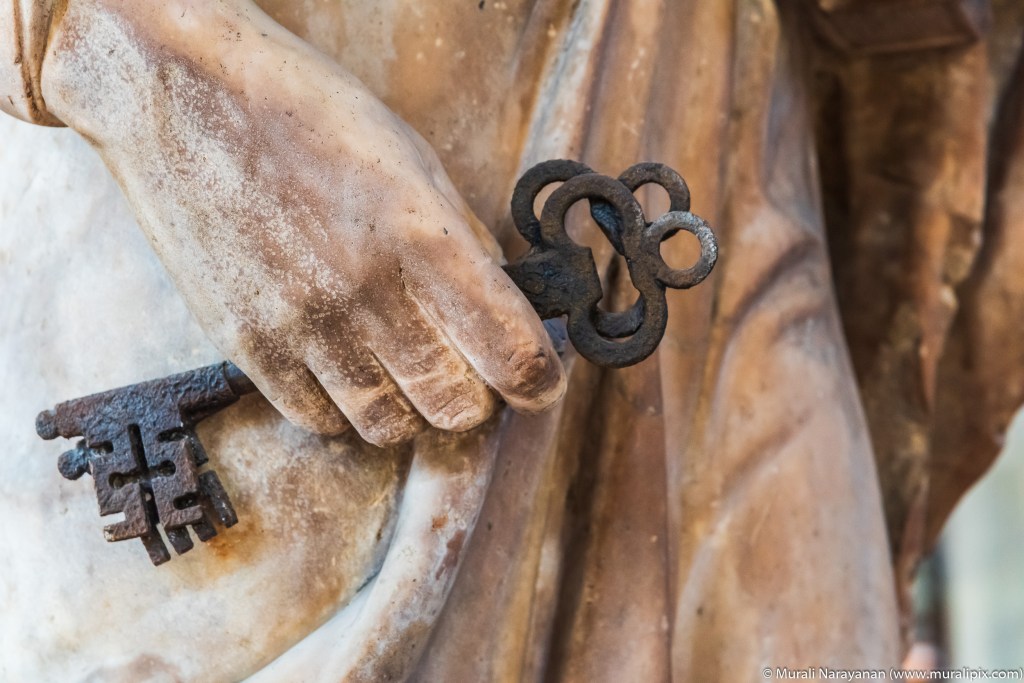
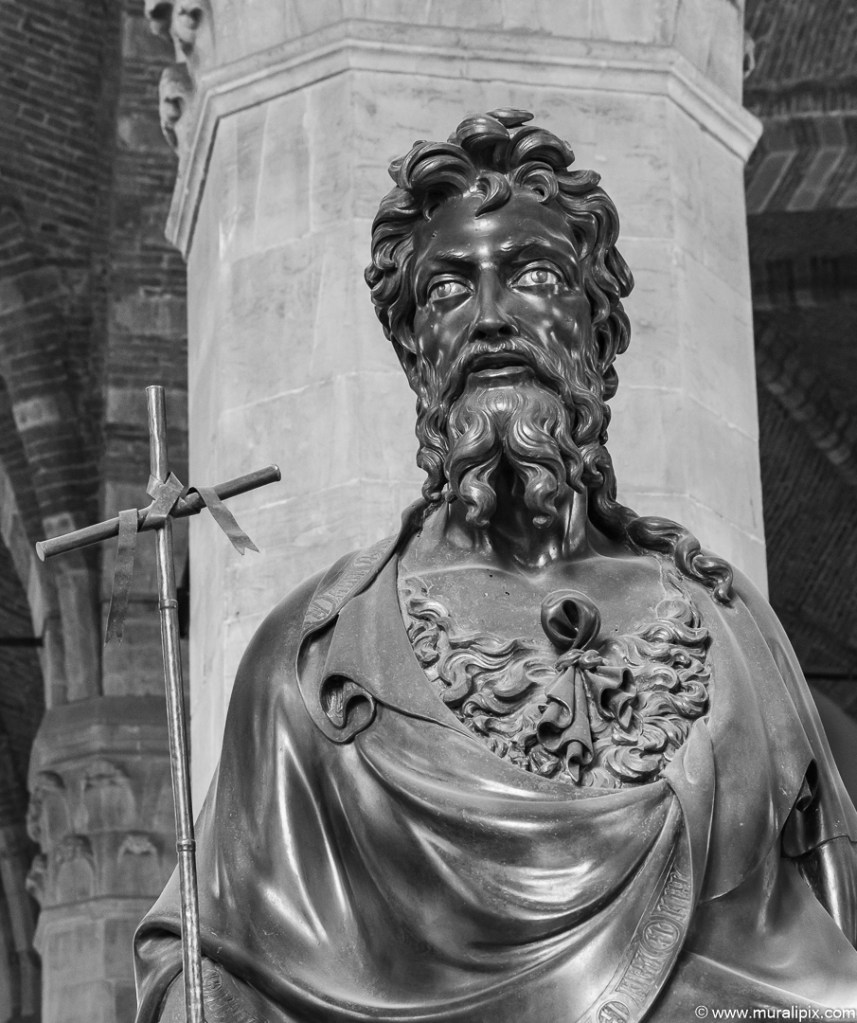

43°46’14.5″N 11°15’18.8″E
The Duomo & Battistero di San Giovanni
After leaving the Orsanmichele church, we grabbed a lunch and walked to the Duomo (aka Cattedrale di Santa Maria del Fiore).
The construction began in 1296 in the Gothic style and was structurally completed by 1436, with the dome engineered by Filippo Brunelleschi. The cathedral complex, in Piazza del Duomo, includes the Baptistery and Giotto’s Campanile.
In August 1418, an architectural design competition for erecting the dome was announced. The two main competitors were Lorenzo Ghiberti and Filippo Brunelleschi, the latter of whom was supported by Cosimo de Medici. Ghiberti had been the winner of a competition for a pair of bronze doors for the Baptistery in 1401 and lifelong competition between the two remained sharp. Brunelleschi won and received the commission. Work started on the dome in 1420 and was completed in 1436.
Books have been written and documentaries have been filmed about the building of the dome. Checkout the following:
https://www.amazon.com/Brunelleschis-Dome-Renaissance-Reinvented-Architecture-ebook/dp/B00DUVKOUW/
https://www.youtube.com/watch?v=RUBnNDloGHg
It remains the largest brick dome ever constructed. The usual way to build a dome was to support it with scaffolding called “centring.” However, the open space in the cathedral was 42 meters wide, and the Florentines wanted a tall, soaring dome. All the timber in Tuscany would not have sufficed to make the centring. Brunelleschi ended up building the dome without scaffolding in such a way that it supported itself as the work progressed.
Brunelleschi’s solutions for the dome were ingenious, innovative, and expensive. The first problem to be solved was purely technical: no known lifting mechanisms at the time were capable of raising and maneuvering the enormously heavy materials he had to work with, including sandstone beams, so far off the ground. He invented a three-speed hoist with an intricate system of gears, pulleys, screws, and driveshafts powered by a single yoke of oxen turning a wooden tiller and the castello, a 65-foot-tall crane with a series of counterweights and hand screws to move loads laterally once they’d been raised to the right height.
The whole structure of the dome is designed to be light and slim in both form and substance. In fact, from an octagonal drum of the dome stand eight segments, the sails, arranged on two shells separated by a space. Brunelleschi wove regular courses of herringbone brickwork, little known before his time, into the texture of the cupola, giving the entire structure additional solidity.
Another of these crucial elements is the lantern, on top of which rests the bronze ball built by Verrocchio in 1472. To position the ball they used machines invented by Brunelleschi. Leonardo da Vinci figured among the apprentices that helped in this difficult operation.

43°46’21.6″N 11°15’19.3″E
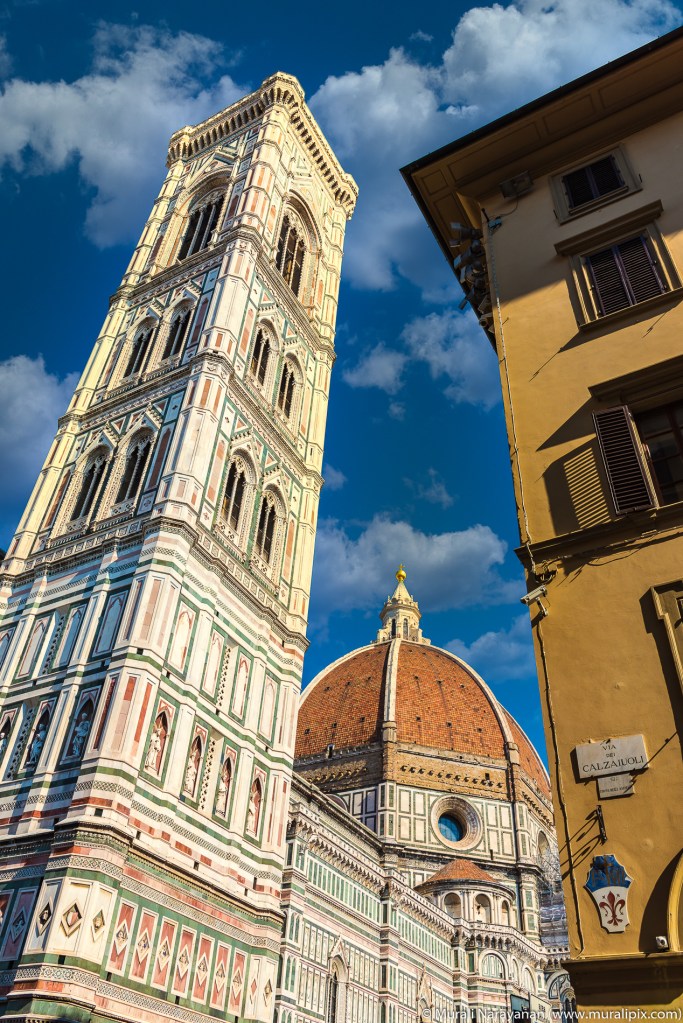
43°46’21.6″N 11°15’19.3″E
By the end of the 15th century, the Duomo had a world-famous Renaissance dome, sitting atop a Tuscan Gothic structure with Gothic/Renaissance side doors – but it still had no facade. By at least 1476, the Medici realized that Giotto’s original plans for the facade were too Gothic to match the Renaissance-style roof, dome, and decorations, and they opened up a new competition to design the cathedral’s outward-facing surface. The competition, however, was not successful. Over the next century, numerous people took charge of the project, which meant that the style was continually changed to adapt to new tastes and fashions, and the facade was never fully completed. The façade was then left bare until the 19th century. Work on the new facade began in 1876 and was completed in 1887.

43°46’23.3″N 11°15’19.9″E
The line to go inside the Duomo was over a mile long and the security guard said that we can expect a 2 hour wait. As I had already been inside the Duomo on a previous visit in 2008, we decided to skip it on this trip. We checked out the Baptistery opposite to the Duomo.
In Christian religious architecture Baptistery is a place for holy bath (baptism) of newly borns. This Florence Baptistery was built in 1059 on the ruins of a Roman house. It is renowned for its three sets of artistically important bronze doors with relief sculptures. The north and east doors were created by by Lorenzo Ghiberti. Michelangelo dubbed the east doors the Gates of Paradise. It took Ghiberti 21 years to complete the northern doors. These gilded bronze doors consist of twenty-eight panels, with twenty panels depicting the life of Christ from the New Testament. It took him an additional 27 years to complete the east doors depicting scenes from the Old Testament. The panels are large rectangles and are no longer embedded in the traditional Gothic quatrefoil, as in the previous doors. He employed the recently discovered principles of perspective to give depth to his compositions.
The Gates of Paradise situated in the Baptistery are a copy of the originals, substituted in 1990 to preserve the panels after over five hundred years of exposure and damage. To protect the original panels for the future, the panels are being restored and kept in a dry environment in the Museo dell’Opera del Duomo, the museum of the Duomo’s art and sculpture.
There was a massive crowd to see and photograph the eastern doors. I had to wait patiently for about 15 minutes to get my turn.
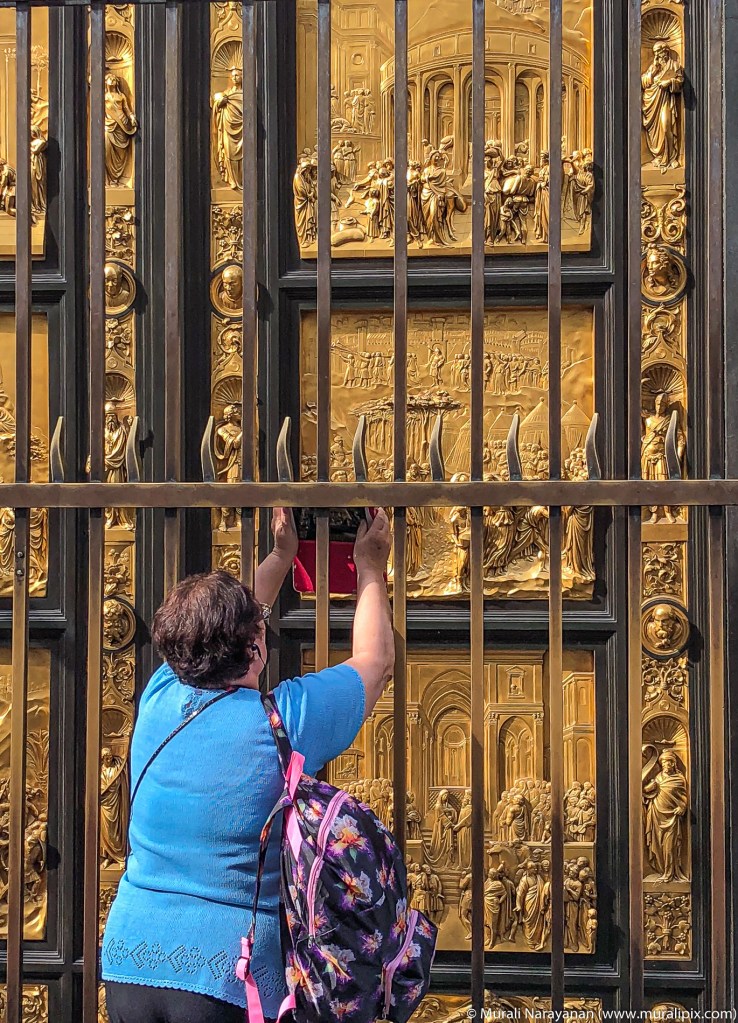
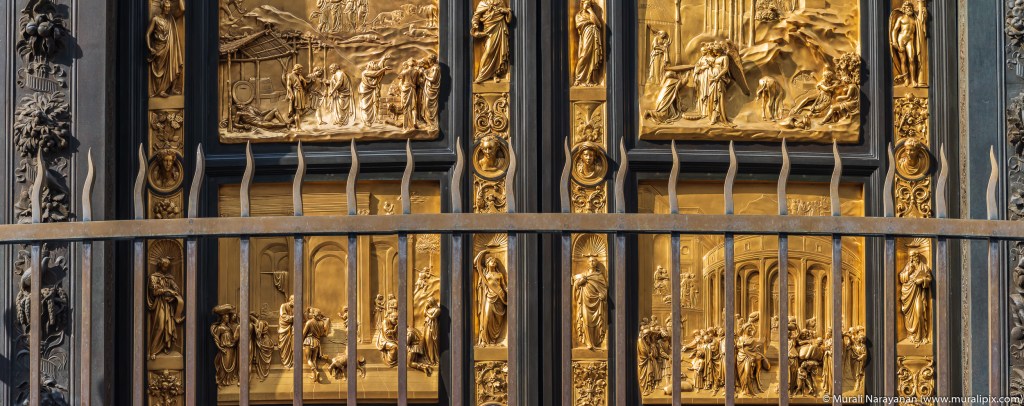
43°46’23.3″N 11°15’19.1″E
